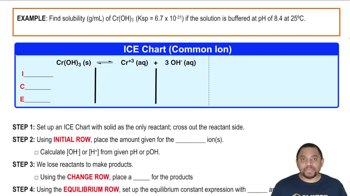Lead(II) carbonate, PbCO3, is one of the components of the passivating layer that forms inside lead pipes. (d) The EPA threshold for acceptable levels of lead ions in water is 15 ppb. Does a saturated solution of lead(II) carbonate produce a solution that exceeds the EPA limit?
The solubility of CaCO3 is pH dependent. (a) Calculate the molar solubility of CaCO3 given Ksp = 4.5 * 10^-92, neglecting the acid-base character of the carbonate ion. (c) If we assume that the only sources of Ca2+, HCO3-, and OH- ions are from the dissolution of CaCO3, what is the molar solubility of CaCO3 using the equilibrium expression from part (b)?
 Verified step by step guidance
Verified step by step guidanceKey Concepts
Solubility Product Constant (Ksp)

pH and its Effect on Solubility

Equilibrium Expressions

For each pair of compounds, use Ksp values to determine which has the greater molar solubility: (a) CdS or CuS (b) PbCO3 or BaCrO4 (c) Ni(OH)2 or NiCO3 (d) AgI or Ag2SO4.
The solubility of CaCO3 is pH dependent. (b) Use the Kb expression for the CO32- ion to determine the equilibrium constant for the reaction CaCO3(s) + H2O(l) ⇌ Ca2+(aq) + HCO3-(aq) + OH-(aq)
Tooth enamel is composed of hydroxyapatite, whose simplest formula is Ca51PO423OH, and whose corresponding Ksp = 6.8 * 10-27. As discussed in the Chemistry and Life box on page 746, fluoride in fluorinated water or in toothpaste reacts with hydroxyapatite to form fluoroapatite, Ca51PO423F, whose Ksp = 1.0 * 10-60. (a) Write the expression for the solubility-constant for hydroxyapatite and for fluoroapatite.
